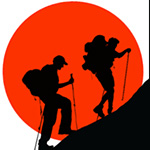Traditional Climbing
Rock climbs that are protected primarily with the gear that climbers place and remove themselves are traditional climbs. Traditional climbing is how the sport has been practiced for decades, and it’s still what most climbers do most of the time, although many now also practice sport climbing. Confusingly, some traditional climbs may have an occasional fixed piton or bolt, and they often have fixed anchors for belays or rappels. However, traditional climbers are always prepared to arrange most of their own protection.
Sport Climbing
Climbs that are protected exclusively with fixed protection usually bolts are called sport climbs, in contrast with traditional climbs on which climbers place and remove their own gear. Sport climbs have developed rapidly at cliffs where there are few cracks for protecting climbs traditionally. Some cliffs consist entirely of sport climbs. Sport climbing is very popular among beginning climbers because it is less expensive and easier to learn than gear-intensive traditional climbing. Because the protection is very solid and easy to use, sport climbing also has allowed climbers to push their limits on very difficult, gymnastic movements, with little fear of the repeated falls that often result.
Top-roping

Though leading is considered the best style and the most fun-in climbing, climbers often top-rope to practice or to climb routes that are difficult for them. In top-roping, the middle of the rope is clipped to an anchor at the top of the climb. Both ends of the rope are at the bottom of the climb. The belayer takes in rope as the climber ascends, so the climber is always protected with an overhead rope and any fall will be very short. Top-roping is very common among beginning climbers, as well as at indoor climbing gyms.
Soloing
Some climbers occasionally tackle a route alone either without a rope or self-belayed with a rope and protection. Since a fall without a rope almost certainly will result in death, this form of soloing is not popular. However, most climbers still regard this as a legitimate way to climb for people who are very comfortable at the level at which they are soloing. Soloing is not the same as free climbing, though the two are frequently confused.
Aid climbing
Cliffs that are too difficult or holdless for free climbing often can still be ascended with the use of direct aid. Unlike free climbers, aid climbers use the pieces of protection that they place for upward progress. The challenge of aid climbing is to ascend very blank faces with minimal tools. Though not as popular as free climbing, aid climbing allows people to scale some of the world’s most dramatic and improbable walls.
Ice climbing
In winter, some climbers like to ascend frozen waterfalls. Ice climbers carry ice axes and hammers with sharp picks that they stick into the ice. They also wear crampons on their boots, with metal points that allow them to kick footholds. For protection, ice climber’s pound or screw metal tubes into the ice.
Mountaineering (Alpine climbing)
Anyone climbing a mountain that requires more technical skills than hiking is mountaineering or Alpine climbing. (The sport originated in the French and Swiss Alps.) Technical climbing in the mountains can be on rock, snowy slopes, or glaciers-sometimes all three. Such climbing is more dangerous than rock climbing on valley cliffs because of Unpredictable hazards such as rockfall, lightning, and other bad weather, altitude sickness, and fatigue. A note on terminology: Rock climbing at a cliff or crag is not “mountain climbing”. Many rock climbers never venture into the mountains and wouldn’t recognize themselves as mountain climbers.
Bouldering
Bouldering is climbing without ropes very close to the ground, where falls are very short and usually inconsequential. Boulderers practice very difficult moves on small outcrops or boulders, often trying many times before succeeding on a given boulder problem. Some use bouldering as practice for bigger climbs; others pursue it exclusively as a rewarding sport in its own right.
Indoor climbing
About a decade ago, climbers discovered they could mould artificial handholds from resin and bolt them to a plywood wall for a place to practice. Since then, commercial climbing gyms have sprung up around the world.
Climbers are attracted to indoor gyms because they offer a place to practice and train in bad weather or at night. The hold is changed frequently, so there are always new problems to try. Gyms have contributed to an enormous increase in climbing standards of difficulty in recent years, some climbers only climb indoors.
Competitions
Though climbers have always been competitive and pushed each other to try more difficult ascents, formal competitions have spread with the advent of indoor climbing facilities. Some climbers focus entirely on training for competitions. There is a world Cup circuit similar to skiing; eventually, climbing may be an Olympic sports Competition that are especially popular among young climbers. So far, more than 50 international competitions were organized around the world.





